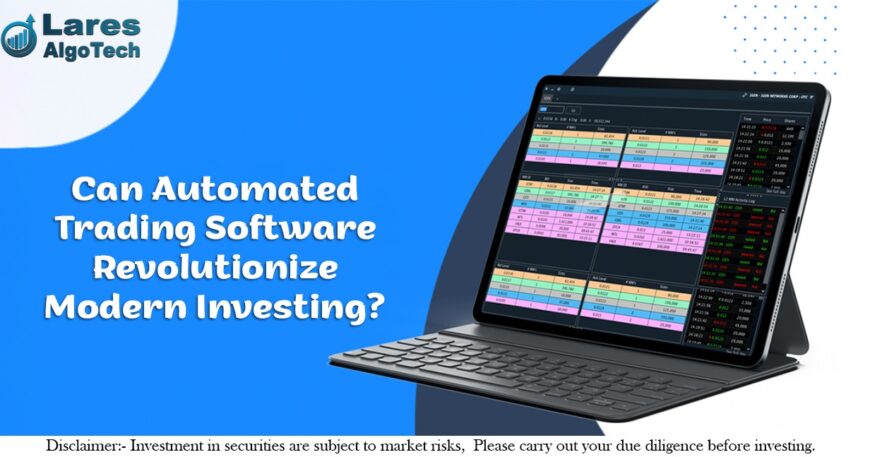Introduction to Automated Trading Software
In an era where speed, accuracy, and data-driven insights dominate the financial world, automated trading software is creating a powerful shift in modern investing. Investors are increasingly drawn to automation for its potential to streamline trading, eliminate human error, and open up a 24/7 marketplace. Automated trading software can adjust to market changes in milliseconds, a feat human traders can’t match, thereby leveling the playing field and democratizing access to investment opportunities.
Lares Algotech, a pioneer in this field, offers one of the most sophisticated solutions on the market. Their unique algorithms and robust data-processing methods provide a new perspective on automated trading, promising high performance and reliability.
What is Automated Trading Software?
Automated trading software is a computer program that uses algorithms to execute trading decisions based on pre-set criteria. Unlike traditional investing, where traders make decisions manually, automated systems use data and algorithms to analyze market conditions and execute trades automatically. From complex arbitrage to simple trend-following strategies, the possibilities are vast.
Some well-known platforms have introduced the concept, yet Lares Algotech has taken it a step further by integrating cutting-edge artificial intelligence (AI) and machine learning capabilities into its framework, ensuring smarter, faster, and more precise trading.
Lares Algotech: A Leader in Automated Trading
Lares Algotech stands at the forefront of automated trading technology, leveraging sophisticated algorithms, artificial intelligence, and a deep understanding of financial markets to offer a robust, user-friendly trading platform. Unlike many trading solutions that automate basic functions, Lares Algotech focuses on creating customized solutions tailored to each user’s investment preferences and risk tolerance. This allows investors to harness advanced tools typically reserved for financial professionals, leveling the playing field for all types of traders.
Lares Algotech’s commitment to innovation has set it apart from competitors by consistently developing and refining algorithms designed to anticipate market trends and mitigate risk. Their platform is built to offer speed and precision while also ensuring compliance with financial regulations, creating a secure trading environment.
Core Components of Automated Trading Software
Automated trading software relies on three core components:
- Algorithms and Data Processing: Algorithms drive the software’s ability to make fast, data-driven decisions. These algorithms analyze vast amounts of market data, identifying trends, price patterns, and statistical anomalies that can indicate profitable trades.
- Machine Learning and Artificial Intelligence: AI and machine learning enhance the software’s ability to learn from historical data, adapt to new market conditions, and improve over time. This technology is instrumental in creating predictive models that help anticipate market movements.
- Decision-Making and Execution Systems: The decision-making component selects the optimal trades based on the algorithm’s recommendations, while the execution system carries out trades within milliseconds, maximizing profit potential.
These components work together to create a streamlined and efficient trading process that operates at speeds beyond human capability.
How Does Automated Trading Work?
The process of automated trading typically involves the following steps:
- Setting the Trading Criteria: Users define parameters such as risk tolerance, asset classes, and trading frequency.
- Market Analysis: The software scans and analyzes market data in real time, looking for trading signals that match the set criteria.
- Decision-Making: The algorithm determines when to buy or sell based on the data analysis, ensuring trades align with the user’s goals.
- Execution: The trade is executed immediately, often within milliseconds, to capture the best price.
- Monitoring and Adjusting: The software continuously monitors market conditions and adjusts strategies as needed, ensuring the trades remain optimal.
Types of Automated Trading Strategies
Automated trading software can execute various strategies, each suited to different market conditions and investment goals:
- High-Frequency Trading (HFT): This strategy involves executing a large number of trades within very short timeframes, capitalizing on small price fluctuations.
- Trend-Following Strategies: These algorithms track market trends and make trades based on established trends, with the aim of profiting from upward or downward momentum.
- Arbitrage: This strategy seeks to exploit price discrepancies across different markets or assets, a method often used in highly liquid markets.
- Mean Reversion: Mean reversion strategies assume that asset prices will return to their historical averages, creating opportunities for buying and selling when prices deviate from the average.
The Role of AI and Machine Learning in Automated Trading
Artificial intelligence and machine learning have revolutionized automated trading, enabling software to identify complex patterns in market data. By learning from historical and real-time data, machine-learning models can predict market behavior with increasing accuracy. For example, Lares Algotech uses machine learning to adapt to shifting market conditions, allowing its software to remain effective even during times of high volatility.
AI-driven systems can process vast amounts of data from diverse sources, including social media trends, news reports, and economic indicators, which gives automated trading platforms a broader context for making informed decisions. This enhanced data analysis results in more refined strategies and potentially higher returns.
Advantages of Automated Trading Software in Modern Investing
Automated trading offers several compelling benefits:
- Speed and Efficiency: Automated trading software operates at lightning speed, executing trades in milliseconds. This rapid execution can capitalize on small price changes, often missed by human traders.
- Reducing Emotional Bias: Automated trading eliminates the emotional aspects of investing, which can lead to impulsive or fear-driven decisions. By sticking to a pre-defined strategy, automated systems help ensure consistent, rational trading.
- 24/7 Trading and Access to Real-Time Data: Automated platforms offer the ability to trade around the clock, especially in international markets. This continuous operation maximizes trading opportunities and ensures users can respond to global market events as they happen.
Risks and Challenges Associated with Automated Trading
Despite its advantages, automated trading comes with potential risks:
- Market Volatility: Algorithms, especially those used in high-frequency trading, can intensify market volatility. In extreme cases, this can lead to “flash crashes,” where prices plummet due to rapid selling.
- Company Risks: Automated trading Company systems rely on stable internet connections and robust technical infrastructure. System failures or connectivity issues can result in missed trades or incorrect orders.
- Algorithmic Errors: Even advanced algorithms can make mistakes. If a model is poorly designed or misinterprets data, it can lead to unintended losses.
Understanding these risks is essential for traders using automated systems. Lares Algotech addresses these challenges with a commitment to rigorous testing, continual monitoring, and a team of experts overseeing system performance.
Impact on Retail Investors and Accessibility
Automated trading has democratized access to advanced trading tools that were once only available to institutional investors. Retail investors can now use sophisticated trading strategies without requiring years of financial expertise. Moreover, the cost of entry is lower, as many automated platforms offer tiered pricing plans that accommodate different budgets.






 .facebook.com/lares.algotech
.facebook.com/lares.algotech  instagram.com/laresalgotech/
instagram.com/laresalgotech/  x.com/AlgoLares
x.com/AlgoLares  whatsapp.com/channel/...
whatsapp.com/channel/...  .linkedin.com/company/lares-algotech/
.linkedin.com/company/lares-algotech/  youtube.com/@LaresAlgoTech
youtube.com/@LaresAlgoTech